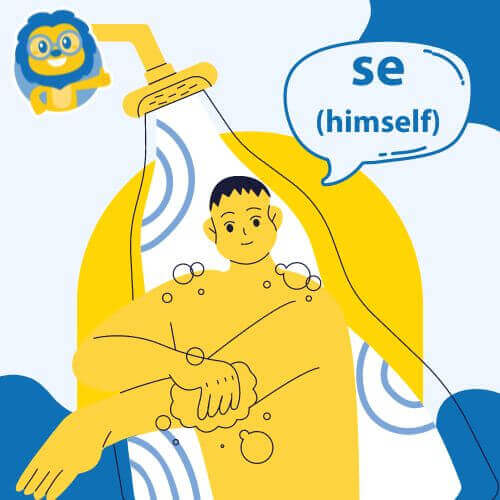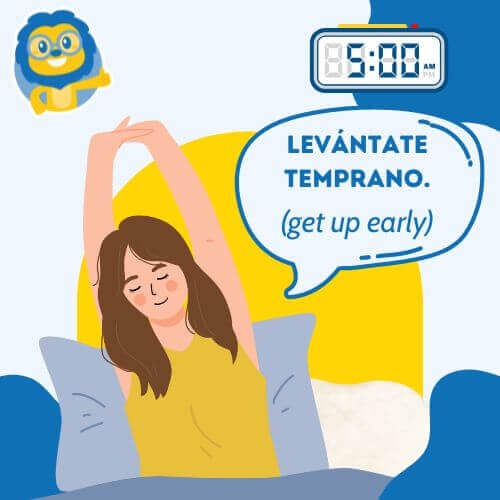
Spanish Grammar Bank
REFLEXIVE PRONOUNS IN SPANISH
Pronouns are a small set of words used as substitutes for nouns. In Spanish, personal pronouns are categorized based on their function in a grammatical context.
In Spanish, we have reflexive pronouns that are used to indicate that the subject of the verb performs the action on itself.

What Are Reflexive Pronouns
in Spanish and How Are They Used?
👉 Let’s start with the basics. Pronouns are a small set of words used as substitutes for nouns. In Spanish, personal pronouns are categorized based on their function in a grammatical context (usually a phrase).

Within the personal pronoun category in Spanish, we have reflexive pronouns, that are used to indicate that the subject of the verb performs the action on itself.
For example: Yo me divierto los fines de semana. (I enjoy myself on weekends).
In the example, the Spanish reflexive pronoun me indicates that the subject (pronoun) yo is performing the very action of enjoying.
So, in a nutshell, reflexive pronouns are used in tandem with reflexive verbs to indicate that the person doing and receiving the action is one and the same.
In Spanish, the main categories of reflexive pronouns are: True Reflexive Actions and Reciprocal Actions.
👉 So in this blog, we’re going to teach you all about reflexive pronouns you need to navigate any conversations in Spain!
🇪🇸 Let’s break down the ‘Spanish Reflexive Pronouns‘ with us!
Reflexive Pronouns in Spanish || What You Need To Know about Them in Spanish
Reflexive Pronouns in Spanish || True Reflexive Pronouns in Spanish
Reflexive Pronouns in Spanish || Placement of Reflexive Pronouns in Spanish
Reflexive Pronouns in Spanish || Matching Pronouns Always – Agreement Between Subject Pronoun and Reflexive Pronouns
Reflexive Pronouns in Spanish || Reflexive Pronouns as Reciprocal Actions
Reflexive Pronouns in Spanish || Intensified Reflexive Actions
Reflexive Pronouns in Spanish || Quiz
Reflexive Pronouns in Spanish || FAQs
Reflexive Pronouns in Spanish || What You
Need To Know about Them in Spanish
📖 Reflexive pronouns are used when the subject (of the verb) performs the action on itself.
Él se ducha por las mañanas.
He showers in the morning.Two things occur (grammatically speaking) with reflexive pronouns, (1) the subject of the verb performs an action on itself, consequently, (2) the subject and the object of the verb are one and the same, they are in agreement (‘he showers himself’).

👉 These are the reflexive pronouns in Spanish:
| REFLEXIVE PRONOUNS | |
| me | myself |
| te | yourself (informal singular) |
| se | himself, herself, itself, yourself (formal singular) |
| nos | ourselves |
| os | yourselves (informal plural) |
| se | themselves, yourselves (formal plural) |
2. Reflexive Pronouns in Spanish ||
True Reflexive Pronouns in Spanish
What differentiates a true reflexive pronoun from other pronoun categories in Spanish is that the reflexive ones require a nearby antecedent (subject) that they must be in agreement with.
Reflexive pronouns, therefore always require an agreement between the subject (the ‘doer’ of the action) and the object (the ‘receiver’ of the action) of the reflexive verb.

Yo me abrigo cuando tengo frío.
I cover myself up when I feel cold.In the example, the reflexive pronoun me indicates that the subject (pronoun) yo is performing the action of covering up.
👉 Here is a rephrased example using a stand-alone pronoun that does not require the subject matching with the person/thing doing the action:
Yo abrigo al gato cuando tiene frío. (I cover up the cat when it’s feeling cold.).
In this rephrased example, the action of covering up is being performed on another (and not directly onto ‘myself’), so there is no reflexive pronoun involved.
3. Reflexive Pronouns in Spanish ||
Placement of Reflexive Pronouns in Spanish
☀ Reflexive pronouns generally come before the conjugated verb. For example, the verb-pronoun tandem being levantarse (to get up), the placement would be as follows:
Me levanto temprano por las mañanas.
I get up early in the mornings.In the example above, the reflexive pronoun me is placed before the conjugated verb levanto, so in tandem, me levanto.
Conversely, with infinitives (in the immediate future tense), gerunds and affirmative commands, the reflexive pronouns are placed at the end of the verb.

Examples of each:
| Future | Voy a levantarme temprano. | I am going to get up early. |
| Present Progressive | Estoy levantándome temprano. | I am getting up early. |
| Imperative (Affirmative) | Levántate temprano. | Get up early. |

Here’s How to Wish Someone Happy Birthday in Spanish🥳
Happy Birthday in SpanishPLUS Traditions and Customs 🎂🎁 Who doesn’t love to celebrate a birthday? Spain is no different! In fact, Spain goes beyond just celebrating one’s birthday. Each one has two special days in a given year in Spain….
4. Reflexive Pronouns in Spanish ||
Matching Pronouns Always – Agreement Between Subject Pronoun and Reflexive Pronouns
📌 We’ve already established that we use reflexive pronouns in Spanish when the subject is performing the action on itself, indicating that there is an agreement between the subject (pronoun) and the reflexive pronoun.
To ensure grammatically correct phrases when using reflexive pronouns in Spanish, always remember these correspondences between the subject pronouns (I, you, he, she, etc.) and the reflexive pronouns (myself, yourself, himself, herself, etc.):
yo (I) ~ me (myself)
ex.: Me rasco a menudo. (I scratch myself frequently.)
tú (you, informal singular) ~ te (yourself)
ex.: Tú te cuidas mucho. (You take good care of yourself.)
usted (you, formal singular) ~ se (yourself)
ex.: Usted se mira en el espejo. (You look at yourself in the mirror.)
él (he) ~ se (himself)
ex.: Él se afeita una vez por semana (He shaves himself once a week.)
ella (she) ~ se (herself)
ex.: Ella se considera alta. (She considers herself tall.)
ello (it) ~ se (itself)
ex.: Ello se mueve solo. (It moves by itself.)
nosotros (we, masculine or when both male and female) ~ nos (ourselves)
ex.: Nosotros nos entretenemos fácilmente (We easily keep ourselves entertained.)
nosotras (we, feminine) ~ nos (ourselves)
ex.: Nos cuidamos de nosotras mismas. (We take care of ourselves.)
vosotros (you, plural and informal masculine or when both male and female) ~ os (yourselves)
ex.: Vosotros os informáis muy bien. (You inform yourselves very well.)
vosotras (you, plural and informal feminine) ~ os (yourselves)
ex.: Vosotras os disfrazáis cada año para Halloween (You dress yourselves up in costumes every year for Halloween.)
Ustedes (you, plural and formal masculine or when both male and female) ~ se (yourselves)
ex.: Ustedes se divierten siempre. (You always enjoy yourselves.)
ellos (they, masculine or when both male and female) ~ se (themselves)
ex.: Ellos se queman cuando cocinan. (They burn themselves when they cook.)
ellas (they, feminine) ~ se (themselves)
ex.: Ellas se maquillan de Maravilla. (They put makeup on themselves marvelously.)]
5. Reflexive Pronouns in Spanish || Reflexive Pronouns as Reciprocal Actions
🔏 Another category of reflexive pronounces is one used to indicate that two or more subjects perform the same action onto each other. These reciprocal pronouns express a mutual action, that is, what two or more people do to each other reciprocally.
For example: Mis amigos se ven cada fin de semana. (My friends see each other every weekend).
👆In the above example, the reciprocal reflexive pronoun se indicates that the action of seeing each other is reciprocal between the mentioned friends.
When using Spanish reciprocal pronouns, always use the plural form of the reflexive pronoun, as an action implicating reciprocity by definition requires at least 2 people.
6. Reflexive Pronouns in Spanish ||
Intensified Reflexive Actions
🔏 Another category of reflexive pronouns is the kind that is used to emphasize the subject’s active role or effort in performing the action, referred to as intensified reflexive actions.
In a way, these pronouns highlight the independence of the subject in performing the action. Here are some examples:
Carlos se hizo hoy la comida a sí mismo. (Charles prepared lunch for himself today.)
Sandra reparó el ordenador por sí misma. (Sandra repaired the computer by herself.)
Did you know? The main point to remember for pronouns in this category, aside from the subject performing the action on itself, is the increased degree of the subject’s personal effort or involvement in the action.
🔎 Some of the most commonly used intensifier pronouns would be: A sí mismo and Por sí mismo
A sí mismo (will vary based on gender or number: a sí misma, a sí mismos, a sí mismas) – to/for oneself, other variants being a ella misma (to herself), a él mismo (to himself), etc.
Por sí mismo (will vary based on gender or number, por sí misma, por sí mismos, por sí mismas) – by oneself, other variants being por ella misma (by herself), por él mismo (by himself), etc.

Reflexive Pronouns in Spanish || Quiz
Now you’ve mastered the reflexive pronouns, why not check out these Spanish essentials?
👉 How to Say Nice to Meet You in Spanish
Reflexive Pronouns in Spanish || FAQs
When to use reflexive pronouns in Spanish?
Put simply, reflexive pronouns indicate that the subject and the object of the verb are one and the same. A common and explanatory example is:
Yo me lavo las manos. (I wash my hands).
In the example, the subject ‘I’ performs the action of washing his/her own hands, so clearly the subject is performing the action on itself.
A fun fact: Lavarse las manos (‘to wash one’s hands’) is also a commonly used idiom in Spanish that means that one is not taking the blame or being held accountable for a certain action, circumstance, event or the like.
What are the reflexive pronouns in Spanish?
The following are the reflexive pronouns in Spanish:
me (myself) – Example: Me lavo las manos. (I wash my hands.)
te (yourself in informal singular) – Example: Te lavas las manos. (You wash your hands.)
se (himself, herself, itself, yourself in formal singular) – Example: Él se lava las manos. (He washes his hands.)
nos (ourselves) – Example: Nos lavamos las manos. (We wash our hands.)
os (yourselves in informal plural) – Example: Os laváis las manos. (You wash your hands.)
se (themselves, yourselves – formal plural) – Example: Ellas se lavan las manos (They wash their hands.)
Where to place reflexive pronouns in Spanish?
Reflexive pronouns are most frequently placed in front of the verb, for example:
Me afeito por las mañanas. (I shave in the mornings).
In the example above, the reflexive pronoun me is located before the conjugated verb afeito (I shave).
However, in the case of a pronoun being used in tandem with an infinitive verb, a present participle gerund or an affirmative imperative form, it is placed after the verb. Examples for each:
A ella le gusta ducharse por las noches. She likes to shower in the evenings.
Ella está duchándose por las noches. She is taking a shower in the evenings.
Dúchate por las noches. Shower in the evenings.
How to conjugate reflexive pronouns in Spanish?
To conjugate reflexive pronouns in Spanish follow these steps:
Firstly, identify the corresponding reflexive pronoun (me, te, se, nos, os, se) that agrees with the subject (yo, tú, él, ella, etc.) of the phrase.
Secondly, conjugate the verb based on the corresponding subject and then place the reflexive pronoun before the verb.
Here is an example following the steps using the phrase ‘I wash my hands’:
Step one: Identify the reflexive pronoun for the phrase ‘I wash my hands’, which would be, me (myself) because I myself (me) am washing my own hands.
Step two: The infinitive form of the verb ‘to wash’ is lavar, so based on the corresponding subject of the example yo (I), we then conjugate the verb and place the reflexive pronoun before the conjugated verb.
End result is: Yo me lavo las manos.
What are Spanish reflexive verbs that change meaning?
In Spanish, some verbs, when used in tandem with a reflexive pronoun, acquire a completely different meaning in comparison to their non-reflexive form. Here are some common comparative examples:
Levantar (to raise, lift) vs. Levantarse (to get up)
Llamar (to call) vs. Llamarse (to be called, as in to be named)
Acordar (to agree, to come to a consensus) vs. Acordarse (to remember)
Parecer (to seem) vs. Parecerse (to look alike)
Encontrar (to find) vs. Encontrarse (to meet or to feel a certain way)
Dormir (to sleep) vs Dormirse (to fall asleep)
Despedir (to let go – in an employment context) vs. Despedirse (to say goodbye)
Want More From LTL?
FANCY LEARNING SPANISH? Check out our online Spanish courses here.
We offer a 7-day free trial to all online students where you can study Spanish 24/7. It doesn’t end there either.
We teach over 10 of the world’s most popular languages 😎
Come and be a part of our amazing community.

Learn Spanish with FlexiClasses
Book online classes with the best teachers in the industry.










